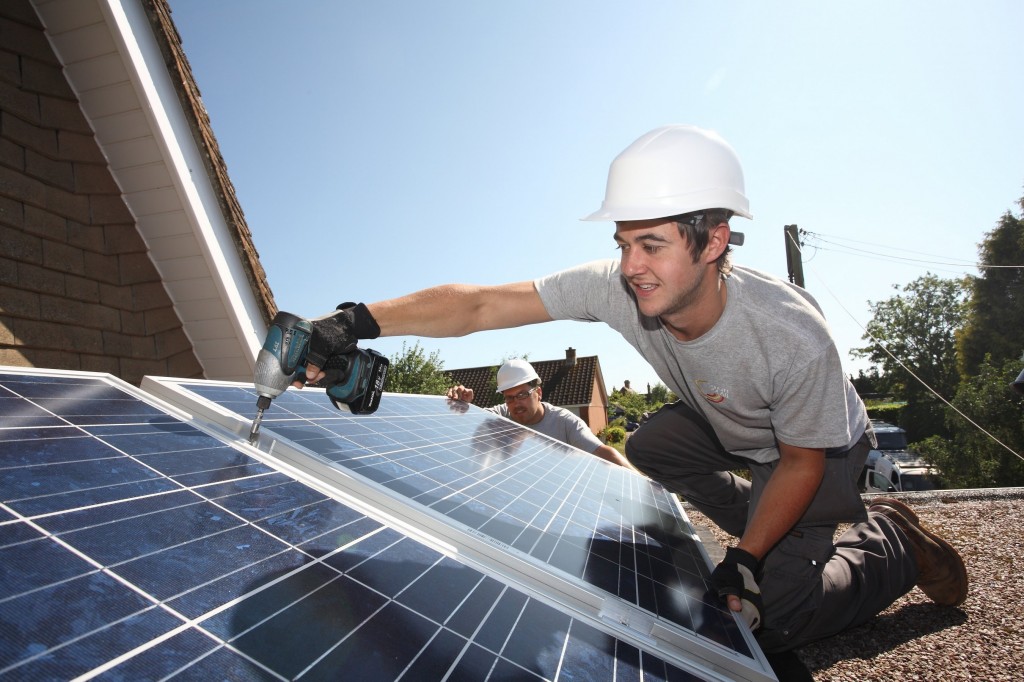In the UK, solar panels produce at full (100%) irradiance if oriented due South at an inclination of 35 degrees while panels facing East or West only produce 79% of the equivalent energy output. However consumption demand peak patterns may now favour East-West orientation.
New research has suggested that panels function more efficiently by facing East-West, while the majority of UK panels face South, so the question is now whether the solar panels on over half a million buildings in the UK could be facing the wrong way.
Taking into account the time of day when peak PV output is produced on South-facing panels, this is usually during low consumption periods in the middle of the day, when people are typically at work. Therefore most of the energy generated is fed to the grid at a feed-in tariff that is considerably lower than that paid by the consumer.
The real energy savings benefits from solar panels accrue by using the energy generated and not by exporting it to the grid. This applies particularly during morning and evening demand peaks so according to some schools of thought, panels should be oriented both East and West.
Germany is now installing East-West facing panels and the question is whether the UK will now follow suit, because if panels are to be mounted in both Eastern and Western orientations, only half of them will be operating at full irradiance during their morning and evening peaks.
Therefore, there is a need to measure irradiance at the proposed location to determine optimum panel placement and orientation. Then when the solar installation has been completed, it needs to be tested. This requires both training and instrumentation.
Training
Site evaluation is one of the first steps that need to be undertaken for effective solar PV generation and this requires thorough training. Inclination, orientation and shading are the three main site factors that influence the performance of a PV installation. While drawings, maps and photos may help determine inclination and orientation, an accurate estimation of shade effects will typically require a site visit.
A solar installation contractor will use a standard estimation method to establish the electrical rating of the PV array in kilowatts peak (kWp), determine the postcode region, determine the array pitch and orientation, and look up kWh/kWp from a location-specific table.
Solar panel installer training is available for people involved in the Solar PV installation chain who may not necessarily carry out the installation, in addition to existing electricians and solar panel providers who would like to offer Solar PV installation to new and existing customers.
Solar Panel training is also available for roofing fitters to learn the techniques of installing solar roofing to a conventional roof. Training teaches correct installation of solar PV panels and includes essential safety information including, working at heights.
Training needs to address installation techniques on different roof coverings available. Training on a purpose built indoor roof and an outdoor solar panel roofing array is also available.
Solar Instruments
There are two groups of instruments used by solar installers: irradiance meters and solar installation testers. Irradiance meters allow an engineer to obtain a reading from solar equipment such as solar panels in order to calculate exactly how much solar power they can generate from a particular location.
Solar irradiance is the amount of solar energy arriving at a specific area. It is important to measure solar irradiance because factors such as the earth’s tilt, cloud cover and the angle of the sun in the sky all play a part.
Solar power essentially depends on the earth’s current location and the state of the atmosphere around it. Solar irradiance meters essentially measure ambient light and provide readings at different times of the day of the amount of sunlight provided at particular times. Shade from trees, overhead power cables and similar obstructions all affect irradiance performance.
Irradiance meters need to be placed as close as possible to the surface where the proposed panels are to be mounted. The highest reading obtained will determine optimum placement for the maximum economic benefit from installing the panels.
In the case of solar installation testers, the tools required for fitting and testing PV solar panels are similar to those used by most electricians, such as clamp meters and multimeters, but with PV-specific measurements on PV peak power and current, depending on the type of inverter installed.
For example, maximum power point tracking (MPPT) grid-connected inverters work by linking low voltage PV panels of typically 24-48V in series in order to raise voltage to the 230V mains requirement. The PV installation contractor will use solar installation tester to measure the output to ensure the panels are functioning correctly.
Conclusion
Solar PV installation is not rocket science but necessitates adequate training and instrumentation in order to fulfil the conditions necessary for maximum power efficiency to ensure the best energy savings from PV installations.
For further information, please visit PASS Ltd’s specialist solar equipment web page.



